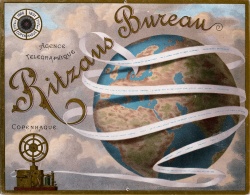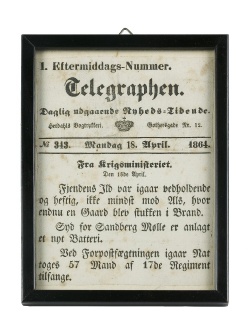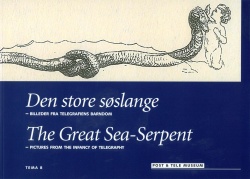The Great Sea-Serpent
01. Sep. 2004

Ritzau's invitation on the occasion of the 25 year jubilee of the news agency illustrates so as to admit of no doubt how they could be first with the latest news from the entire globe by means of the telegraph. Photo: Ritzaus, Danmark.
A Fairy-Tale
The Great Sea-Serpent is also the title of a fairy-tale written in 1871 by Hans Christian Andersen who was completely carried away by new technologies. The fairy-tale is about the Atlantic connection - "the great, miles long telegraph cable which men laid down between Europe and America" in 1866.
For decades after Hans Christian Andersen wrote his fairy-tale, the telegraph continued its adventurous development and got hold of users all over the world. Mainly business men and people of the press were in direct contact with the telegraphers. The telegraph contributed to internationalization and increased speed of communications which by far exceeded the changing effect of the internet on the information society of the millennium.

Several times a day the Copenhageners - hungry for news - received information about the battle at Dybbøl Mill. The first afternoon issue of the "Telegraphen" of 18th April 1864, the day that has gone down to Danish history as the day when Dybbøl fell, is a good source to the veracity that the increased speed of communication did not necessarily mean a better overview of the course of events.
Photo: The Telegraph Regiment's Historical Collection, Fredericia.
First with the Latest
Eventually, as the telegraph network became in-creasingly fine-meshed, news from distant parts of the world could reach the editorial offices of e.g. Danish newspapers in few hours. The readers began to feel close to all sorts of incidents, and several newspapers incorporated the word telegraph in their names in order to signal that they were making use of the possibilities of the telegraph.
Newspapers typically received their news from agencies like Reuter's or Ritzau's, both known even today for broadcasting news telegrams shortly after events have taken place. The increased flow of news and the growing number of up-to-the-minute accounts caused some concern that the readers would eventually repress the profound analyses.
The thematic book has been produced on basis of the unique material which was collected in connection with the temporary exhibition "ONLINE - 150 Years on the Net". It is available from Post & Tele Museum at the price of DKK 140 (+ postage).

Cover of The Great Sea-Serpent with illustration by Lorentz Frölich.
This article may be copied or quoted with MuseumsPosten, Post & Tele Museum as source.
Comment this article
Only serious and factual comments will be published.